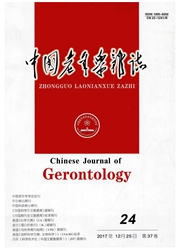

 中文摘要:
中文摘要:
目的分析南京市中老年居民的膳食脂肪酸摄人量及主要脂肪酸的食物来源。方法利用食物频率调查法,结合食物成分表及文献资料的脂肪酸数据库,对1096名45岁以上的南京市中老年居民的膳食脂肪酸摄入量及食物来源进行分析。结果南京市中老年居民每人摄人的脂肪酸为119.2g/d,其供能比为38.57%。饱和脂肪酸(SFA)、单不饱和脂肪酸(MUFA)和多不饱和脂肪酸(PUFA)摄入量分别为28.07、39.08、40.56g/d,SFA:MUFA:PUFA为1:1.39:1.45,n-6/n-3系列多不饱和脂肪酸比值为12.70。饱和脂肪酸的主要来源是肉类(33.14%)和食用油(20.02%),单不饱和脂肪酸的主要来源是食用油(31.49%)、肉类(28.98%)和干果类(19.01%),多不饱和脂肪酸的主要来源是食用油(27.73%)、干果(26.13%)和肉类(21.95%)。膳食中n--6系列多不饱和脂肪酸的主要来源是食用油(28.07%)、肉类(22.28%)和干果类(27.81%),n-3系列多不饱和脂肪酸的主要来源是食用油(25.48%)、豆及豆制品类(25.71%)、肉类(21.14%)。结论南京市中老年居民膳食结构中脂肪供能比偏高,n-6/n-3PUFA比例偏高,应降低脂肪摄入量特别是n-6型多不饱和脂肪酸的摄人。
 英文摘要:
英文摘要:
Objective To analyze the dietary fatty acids intakes and their food sources among the middle and elderly residents in Nanjing. Methods Based on food-frequency questionnaire and the fatty acids contents in food composition table and some literatures, the in takes of dietary fatty acids and their food sources were analyzed for a total of 1 096 residents over 45 years old in Nanjing. Results The in takes of the dietary fatty acids werell9. 2 g/d and provided 38.57% of total energy for the middle and elderly residents in Nanjing. The in takes of SFA,MUFA and PUFA were 28. 07,39.08 and 40. 56 g/d,respectively. The ratio of SFA,MUFA and PUFA(S/M/P)was 1:1.39: 1.45 ,and the ratio of n-6/n-3 PUFA was 12. 07. The majority of SFA came from meat(33.14% ) and edible oil (20. 02% ) ,the majority of MUFA came from edible oil (31.49%) ,meat (28.98%) and nuts ( 19.01% ) ,the majority of PUFA came from edible oil (27.73%) ,nuts (26. 13% ) and meat (21.95%). The majority of n-6 PUFA came from edible oil (28. 07% ) ,meat(22. 28% ) and nuts (27. 81% ). The majority of n-3 PUFA came from edible oil (25.48%), beans and soy products (25.71%), meat (21.14%). Conclusions For the middle and elderly residents in Nanjing,the dietary intakes of fat is higher to provide energy and the ratio of n-6PUFA to n-3PUFA is higher com pared to that recommended, so total fat the n-6 PUFA intake should be decreased in diet. These mean that the meat amount in dietary should be decreased, the intaking amount of fishes and shrimps should be increased, and the dietary of edible oil should be variety, which will con- tributed to the balance of fatty acids in dietary and will decrease incidence ratio of cardiovascular diseases.
 同期刊论文项目
同期刊论文项目
 同项目期刊论文
同项目期刊论文
 期刊信息
期刊信息
